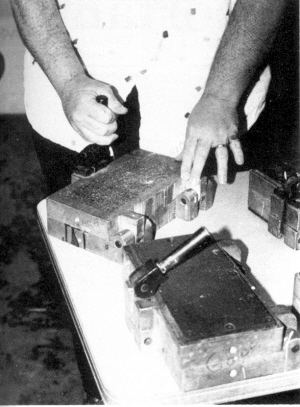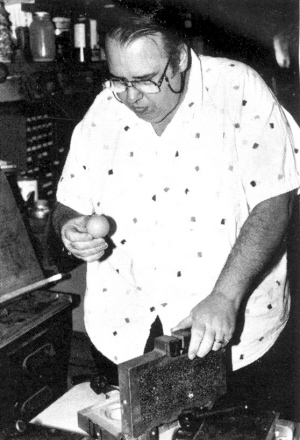 |
 |
Page 19 Spring 1991
|
Radtke
is no different from the other makers in jealously guarding his
ingredients and process. He said he uses the same
silicone material that forms artificial heart
The
biggest challenge faced in the manufacturing process is to avoid air
bubbles. Radtke said he worked for two or three years to overcome
that problem. He's also proud that his balls have no visible "sprue"
or "vent" spots. They do have seams, though, because he
said, "you can't make
a ball without a seam."
Though
he runs a small shop, Radtke has some advantages that Dube and Smith
cannot match. First of all, he has molds to produce balls in nine
sizes, from 3/8" all the way to 3-1/16". He has also
devised a process to incorporate a juggler's initials, or other
design, permanently into the surface of the ball during its
manufacture.
Paul
Bachman, who got the first batch of Radtke's initialized balls,
pointed out the utilitarian value of that feature. He said,
"It's a silicone ball world out there now. With everyone having
a set, you can keep track of your own in a crowded gym when your
initials are right there in the ball."
While
he doesn't exactly resent the fact that Dube and Smith have become
the mass marketers of the product he invented, Radtke follows a code
of ethics that takes the others to task for him. He said, "I
got permission to put the diminishing golf ball on the market after
its original inventor, Laurie Ireland, died. I didn't have to get
permission, but I do everything as ethically as possible. A silver
extraction coin I make was originated by a dentist, Doc Zola. When a
guy told me he wanted one and Doc wasn't making them anymore, I made
one for him. But first I showed it to Doc and asked him if I could
make them. He said I could, and I made it better than he did.
"Let's
just put it this way, if I knew someone was making silicone juggling
balls, I wouldn't have made them, too. I'm not resentful, but
sometimes I feel hurt. But they're in business to make money and I
suppose that's what they do. Fortunately I don't have to earn my
living doing it."
He
said he never even considered trying to patent a silicone ball
because a friend in the magic business called patents "an
invitation to a law suit," and not worth the trouble unless the
product had a potential for huge sales.
So,
under the business name of "The House of Fakini," he remains
as a smalltime producer of silicone juggling balls and a few other
magic props. He says the balls are only 10 percent of his small business,
that the majority is multiplying golf balls, billiard balls and
flowered items. He performs magic occasionally around Toledo. His
performing name, "Fakini, the Fat Fabulous Fascinator," is
to make sure no one is surprised at what they have hired when he shows
up for a performance at 340 pounds - after losing 70!
All
three manufacturers say that despite
their high price, silicone balls are not a big profit maker. The raw
material is expensive, they're labor intensive, and you can only make
a few at a time. Radtke says his chief reward for his groundbreaking
effort has been new friends in the juggling community. "I really
enjoy talking to jugglers, and have met a lot of them by making these
balls," he said.
0 (If
you 're interested in finding out more about Radtke's silicone balls,
write: Frank Radtke; Toledo, OH.) |
 |
 |